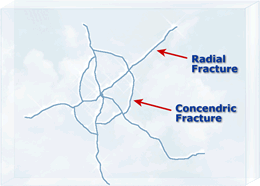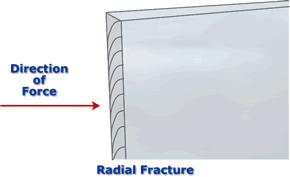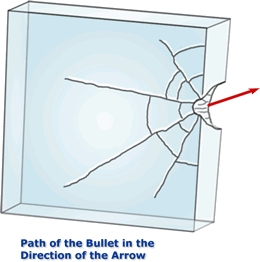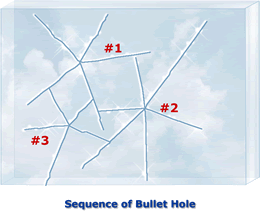Evidence Collection Handbook - TRACE EVIDENCE
The trace analysis section is that section of the laboratory which examines evidence that does not conveniently fit into the other classifications. Paint, glass, soil, and fibers however, are the most common types of evidence which are included in trace evidence, and each will be discussed. As can be concluded from the title, trace evidence refers to the size and quantities of evidence that can be collected. Paint chips, a few bits of glass, and soil stuck to shoes are examples. Sometimes relatively large quantities are present but usually just trace amounts are available. Currently most trace cases are worked by chemists in the Central Lab, but some regional labs perform limited services in this area.
The Kentucky State Police Laboratory System has available Trace Evidence Kits to help in the collection and preservation of trace evidence. These kits contain zip-lock plastic bags for samples like soil, round metal "pillboxes" for small particles, paper envelopes with folded paper packets, a scalpel for collecting evidence, and evidence seals.
Fibers and Fabric
Fiber examination and fabric comparisons can be encountered in a variety of types of criminal cases. This analysis is performed by a trace analyst.
Fiber identification can be a great value in most types of investigations and prosecutions. Crimes such as murder, rape, accident investigation, robbery and assault can have fiber evidence. Fiber identification can sometimes give important investigation leads as well as good evidence for the prosecution purposes after further analysis is concluded.
-
The type of fiber can be determined by microscopic, chemical, or instrumental tests either when found individually or as part of a fabric. Synthetics, like polyester, nylon, etc., constitute the majority of fibers used in the U.S. today. Wools, camel hair, and silk are examples of fibers from animal sources. Cotton, linen, hemp fibers, and jute are examples of plant fibers. The wood fibers in paper are also fibers of vegetable origin. Asbestos is a mineral fiber.
-
Comparisons of fibers of the same type of material include the presence of dyes and a number of microscopic features. Comparisons can be made with fibers from a fabric to individual fibers or from fibers removed from another piece of fabric. A fiber match, however, constitutes only class evidence.
-
The weave pattern of fabrics can also be compared, and sometimes, when a piece has been torn from a fabric, that piece can be matched up with weave pattern and irregularities of a mutual tear edge. This is a example of individual characteristics.
-
Similarly, cordage (ropes, string, etc.) tears and cuts can be matched if the ends are not too frayed or distorted.
-
Fabric impressions may be found in a number of situations. The impression of a victim's garment may remain on the oil pan or on another flat surface of a vehicle in an accident investigation.
-
Since fiber evidence is generally small in nature, care should be taken to prevent loss or contamination.
-
Several methods could be used in the collecting of fiber evidence: visual searches, alternate light sources and searches with additional magnification.
-
Recovery of evidence should be the most direct but least intrusive technique practical. This could include picking, scraping, or vacuuming.
-
Wrap clothing or items to protect adhering fibers if collection is to be done by laboratory personnel.
-
Known samples should also be submitted for comparison purposes.
-
All items should be sealed and labeled for identification.
Paint
Paint chips and paint scrapings can be left in the clothing of a hit-and-run victim or transferred to or from a car that has been hit by the hit-and-run vehicle. Paint chips or scrapings from a house or business can also be in the clothing or on the tools of a burglar. Criminal mischief cases frequently include paint evidence.
Depending on the amount of sample, paints can be analyzed to determine their pigments and the specific type of paint. The make, model, and year of a vehicle sometimes can be determined from paint samples of the original finish. Most important, however, is the comparison of the chip or scraping to a known sample coming from the suspected source vehicle or building.
-
All samples from painted surfaces should be
collected in such manner as to obtain a paint sample with
all the layers of paint present. In other words, the sample
should be chipped off down to the unpainted surface. Chips
are then to be put in one of the metal "pillboxes" provided
in Trace Evidence Kits. Do not use tape to transfer or pick
up paint samples.
-
It is sometimes more desirable to submit an
easily removed item (trim or molding from a vehicle) as is
and let the laboratory remove any foreign paint
-
If submitting clothing for trace paint
analysis, air dry and the place each garment in a separate
bag.
-
If submitting a tool for paint analysis,
wrap the ends in plastic or place it in one of the plastic
bags in the Trace Evidence Kit.
-
Identifying marks should be placed on the
sample containers.
Glass
Glass is found in many types of cases. Glass, like paint, is often involved in burglaries and hit-and-runs. Glass fragments easily embed in shoes and clothing of people involved in the breakage of glass. Glass can give both class characteristics and, in the case of a reconstructed piece of glass that was broken, it can provide individual characteristics when the fractured pieces fit to either.
-
Most glass analysis consists of comparing the refractive indices, elemental compositions, and densities of two or more samples. These are class characteristics of glass.
-
Sometimes a fractured glass object, such as a headlight lens, can be reconstructed. Due to the vast number of ways such a lens could break, a piece of glass fitting into such a reconstruction perfectly would constitute an actual identification.
-
A determination of the direction of force in breaking a window pane can be determined by the direction of the rib marks--stress marks left on broken edges of glass that are perpendicular to one side and that curve tangentially (run almost parallel) to the other side. On radial fractures (those radiating from the center) the direction of the force used to break the window is on the same side as the tangential (almost parallel) parts of the rib marks. On concentric fractures, the relationship of the force to the rib marks reverse, for the side of the perpendicular part of the rib mark is the side from which the breaking force came. (See figures
below).
-
In the case in which a window is broken by a bullet being fired through it, it is possible to determine the bullet's direction by noting the side of the cone-shaped hole left by the bullet. The small opening is on the entrance side and the large opening is on the exit side.
-
A determination of the sequence of bullet holes can be made by noting the radial fractures. Radial fractures caused by the passage of a bullet will stop at any pre-existing fracture. See
figure below.






-
In collecting glass samples, it is best to make sure that representative sample of known glass is collected. This is best done by collecting the four corners of a broken window. When this is not the case or when the glass broken is not a window, collect all the glass that is available.
-
If more than one type of glass is broken, collect representative samples of each different type.
-
The round pillboxes are the best containers for small glass samples.
-
Glass, when broken, flies back and lodges in the hair and clothing. If clothing is to be submitted, allow it to dry first and then package in individual paper bags. The soles of shoes frequently pick up glass fragments.
-
For the reconstructing of glass, lenses, or panes, collect all the glass possible and carefully package to prevent further breakage.
-
Direction of force is best determined at the scene from pieces of glass still in the frame. The lab cannot make such a determination from one isolated piece. If such material is to be submitted, be sure to remove as much glass as possible from the frame and mark the pieces to indicate the inside or outside.
Soil
Soil is frequently found on clothing, shoes, or tools and in the wheel wells of vehicles.
Most soil analysis consists of comparing two or more samples by their mineral content, color, and density. The presence of pesticides and herbicides have also been used in soil comparison.
-
Clothing or shoes should be dried and then placed in individual paper bags.
-
Known soil samples should be collected as follows:
-
one sample at the point of suspected origin;
-
one sample on each side about one foot away
-
one sample on each side about ten feet away.
These samples should be taken from approximately the same depth as the questioned sample. If a shoe print is one quarter of an inch deep, do not sample an inch or more in depth. The zip-lock plastic bags in the trace kit are convenient for such a sample. A bag about half-full of soil would provide an adequate sample.
Miscellaneous
Trace evidence also includes a "Miscellaneous" section. This would include safe insulation, plastics, rubber, ink, dyes, wood, herbicides, pesticides, plaster, concrete, building materials, petroleum products, tape, adhesives, acids, alkalis, other corrosive materials, etc., etc. Physical matches of plastic parts of vehicles or equipment, tape ends, and broken tools are performed both by trace and by firearms analysts.
In collecting such evidence, use a container appropriate for similar evidence listed under paints, glass, and soil.
BE SURE THAT EACH ITEM IS PROPERLY IDENTIFIED WITH INITIALS.
The Central Forensic Laboratory provides the full service of trace analysis. Any mailed shipments should be sent there marked "Attention: Trace". Some regional laboratories will be able to perform certain analysis, depending upon the equipment and time available, but it would be impractical to give a list of each lab's capabilities when a telephone call would answer a specific question.
|